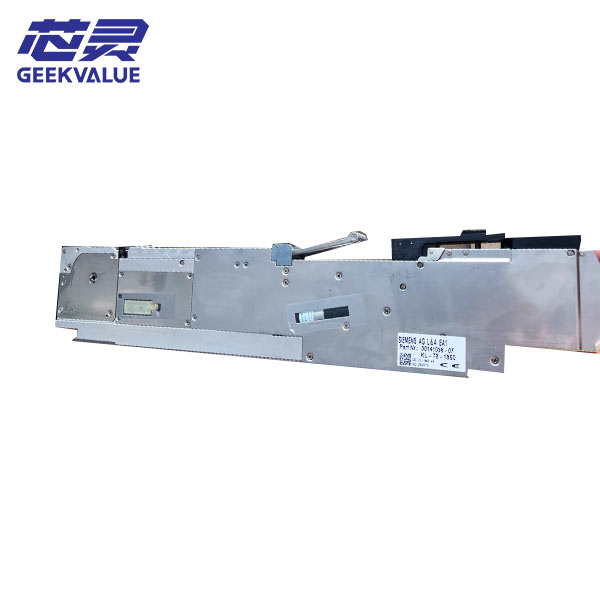Siemens Feeder SMT 3X8 is a key feeding device in the SMT (surface mount technology) production line, designed for efficient and accurate electronic component placement. Its name "3X8" represents a specific feeding specification and arrangement, where "8" refers to the number of tapes that can be loaded at a time, and "3" is related to the tape spacing or feeding mode.

Siemens Feeder Core working principle
Tape conveying mechanism
The gear system is driven by a precision stepper motor to pull the tape forward according to the set step distance
Component positioning system
Optical sensors are used to detect the tape positioning holes to ensure that each component stops at the precise picking position
Pressing and releasing device
The upper cover presses the tape to prevent displacement and automatically releases the component packaging film when picking
Electronic control system
Communicates with the host to receive instructions and feedback operating status and error information
Core advantages of Siemens Feeder 3X8 Feida
High-efficiency production
Supports simultaneous feeding of 8 different components to reduce downtime for material change
Feeding speed up to 0.06 seconds/piece
Compatible with a variety of packages for large components from 0402 to 24mm
Excellent accuracy
Feeding repetition accuracy of ±0.03mm
Patented anti-shake design ensures stability at high speed
Temperature compensation system reduces the impact of environmental fluctuations
Intelligent upgrade
Equipped with RFI D intelligent identification system, automatic reading of component parameters
Supports digital silo management, real-time monitoring of component usage
Programmable feeding strategy, optimized mounting path
Durable design
Aviation aluminum main structure, 30% lighter and stronger
Key components are wear-resistant, with a life of more than 10 million cycles
Modular design, 90% of components can be quickly replaced
Main functions and technical features
Fungsi dasar
Multi-specification tape compatibility (8mm/12mm/16mm/24mm, etc.)
Electric tape stripping (optional pneumatic assistance)
Dual sensor error detection (tape end + component presence)
Automatic tension adjustment system
Advanced features
Intelligent calibration system
Automatic position calibration at startup
Continuous compensation for mechanical deviations during operation
Historical data learning to optimize parameters
Mixed feeding mode
Standard mode: Sequential feeding
Jump mode: Cross Material level feeding
Backup mode: automatic switching between main and standby materials
Status monitoring
Real-time monitoring of motor load
Record feeding times and error history
Pengingat pemeliharaan prediktif
Parameter teknis
Power supply voltage: 24VDC±10%
Power consumption: standby <5W, peak <50W
Working temperature: 15-40℃
Humidity range: 30-70%RH (non-condensing)
Noise level: <65dB (1 meter distance)
Role and value in production
Jaminan kualitas
Reduce the risk of wrong material caused by human intervention
Precise feeding reduces the chip offset rate
Automatic verification of component polarity
Cost control
Tape utilization rate reaches 99.8%, reducing waste of tail materials
Energy consumption is 40% lower than that of traditional feeders
Maintenance costs are reduced by 60%
Flexible production
Quick switching supports small batches of multiple varieties
Seamless connection with MES system
Remote recipe management function
Data value
Generate component consumption report
Record equipment OEE data
Provide basis for process optimization
Siemens Feeder Precautions for use
Installation specifications
Ensure installation when the SMT power is off
Check that the material rail width matches the material belt (8mm/12mm/16mm)
Correctly set the material station offset parameters
Confirm that the RFID tag information is consistent with the program
Operation points
Check the material belt tension before loading to avoid too tight/too loose
Clean the material belt channel regularly (recommended once every 4 hours)
Keep at least 3 components as a guide when replacing the material tray
Abnormal alarms should be immediately suspended for inspection, and forced operation is prohibited
Environmental requirements
Avoid direct sunlight or use near strong heat sources
Prevent interference from vibration sources (such as large stamping equipment)
Work surface level <0.1mm/m
It is recommended to equip with a stabilized power supply
Safety warning
Do not put your fingers into the moving mechanism area
Electrical connections must be made by professionals
If there is abnormal heat or odor, turn off the power immediately
Waste tapes must be professionally recycled
ASM/Siemens Feeders Common error messages and solutions
| Error code | Arti | Larutan | Preventive measures |
|---|---|---|---|
| E101 | Material belt advances beyond limit | 1. Check if the material belt is stuck2. Reset the material belt position3. Check the sensor status | Lubricate the guide rail regularlyKeep the material belt flat |
| E205 | Component detection failed | 1. Clean the optical sensor2. Adjust the detection threshold3. Check the component spacing setting | Use standard package material beltAvoid strong light interference |
| E307 | Motor overload | 1. Stop running immediately2. Check the mechanical resistance point3. Measure the motor winding | Avoid continuous overload operationKeep the ambient temperature suitable |
| E412 | Communication interruption | 1. Check the data cable connection2. Restart the control system3. Update the firmware version | Use shielded cableAvoid running parallel to strong electricity |
| E508 | RFID reading failed | 1. Clean the tag and reader2. Re-enter the component information3. Check the source of RF interference | Standardize the label pasting positionKeep away from high-frequency equipment |
Special error handling process:
If the same error occurs three times in a row, contact after-sales service, and do not try to reset repeatedly.
Siemens SMT Feeders Maintenance method
Daily maintenance (per shift)
Clean the dust on the material channel with an air gun (use compressed air below 0.3MPa)
Check the spring tension of the pressure cover
Confirm that all fasteners are not loose
Record the number of operating hours and the number of alarms
Weekly maintenance
Add special grease to the gearbox (SIEMENS PN:123456)
Optical sensor calibration
Test all function button responses
Backup equipment parameters
Monthly maintenance
Disassemble and clean the internal mechanism
Measure the motor insulation resistance (>10MΩ)
Replace the worn feed gear
Comprehensive accuracy calibration
Annual overhaul
Return to the factory for professional inspection
Replace all wearing parts packages
Control system upgrade
Re-do anti-static treatment
Reference for key component life
Drive gear: 800,000 times
Stepper motor: 1,500 hours
Sensor: 5 years
Motherboard: 10 years
SMT Feeders Technology evolution and selection suggestions
New generation 3X8 feeder improvements
Use brushless motor, life extended to 2,000 hours
Integrated visual positioning system
Supports Industrial Internet of Things (IIoT) access
Green design with 15% lower energy consumption
Selection considerations
Component type and size range
Target placement speed (CPH)
Workshop environment conditions
Existing equipment compatibility
Intelligent management requirements
Comparison of different versions
Basic version: Meets conventional placement
High-speed version: Suitable for small components below 0201
High-precision version: For precision devices such as QFN/BGA
Anti-static version: For sensitive components
It is recommended to make a final purchase decision after actual placement test
Siemens 3X8 feeder provides a reliable feeding solution for modern SMT production through its innovative multi-channel design, intelligent control system and precision mechanical structure. Proper use and maintenance can not only maximize equipment efficiency, but also significantly improve the overall yield and flexibility of the production line. With the development of Industry 4.0, SMT feeders will be more intelligent in the future, and deep integration with MES/ERP systems will become standard configuration. It is recommended that users establish a complete equipment file and conduct regular professional training to give full play to the full potential of this precision equipment.



